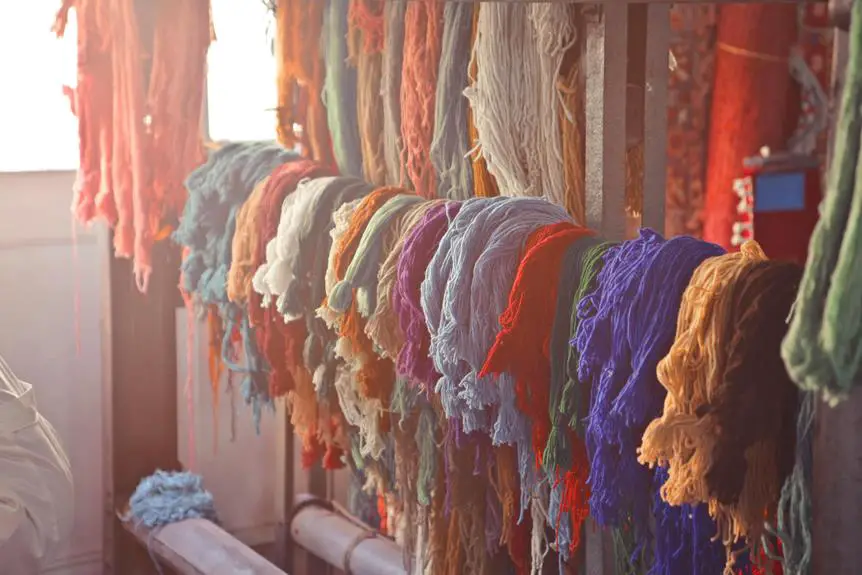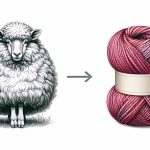Can you guess what acrylic fiber is made of? Chances are, you might not know the surprising origins of this versatile material.
In this article, we'll delve into the fascinating world of acrylic fiber, uncovering its composition, production process, and unique properties. Whether you're a textile enthusiast, a fashion designer, or simply curious about the materials around you, understanding the science behind acrylic fiber can provide you with a deeper appreciation for this widely used synthetic textile.
So, let's unravel the mystery and gain a mastery of what acrylic fiber is truly made of.
Key Takeaways
- Acrylic fiber is a synthetic alternative to wool and cotton, developed in the mid-20th century.
- It is composed of acrylonitrile, a petrochemical derived from natural gas and petroleum, and is manufactured through polymerization.
- Acrylic fiber offers durability, resistance to sunlight, and a soft, wool-like feel, making it suitable for various applications such as clothing, upholstery, and carpets.
- The production process of acrylic fiber raises environmental concerns due to the use of petroleum-based raw materials, but advancements in technology are leading to more sustainable production methods.
The Origins of Acrylic Fiber
Acrylic fiber was first developed in the mid-20th century as a synthetic alternative to wool and cotton. Its origins can be traced back to the desire for a material that combined the desirable properties of both wool and cotton, but at a more affordable cost. The development history of acrylic fiber is rooted in the pursuit of a versatile and durable textile material that could mimic the warmth and softness of wool, while also being easy to care for and resistant to mildew and moths.
The chemical structure of acrylic fiber is composed of acrylonitrile, a petrochemical derived from natural gas and petroleum. This chemical structure allows acrylic fiber to be manufactured through a process of polymerization, where acrylonitrile is combined with other chemicals to form long chains of synthetic fibers.
In terms of its environmental impact and sustainability concerns, acrylic fiber has faced criticism for being derived from non-renewable resources and its potential to release microplastics when washed. However, advancements in recycling technologies and the development of more sustainable production methods have aimed to mitigate these concerns and improve the environmental footprint of acrylic fiber.
The Chemistry Behind Acrylic Fiber
Curious about the science behind acrylic fiber? Let's break it down.
We'll explore the composition of acrylic polymers, the chemical synthesis process, and the unique properties and applications that make acrylic fiber a versatile material in various industries.
Acrylic Polymer Composition
You may be interested to know that the composition of acrylic polymer, the foundation of acrylic fiber, includes a blend of synthetic resins and chemicals. This unique combination allows for the creation of a polymer structure that's composed of long chains of repeating units, giving acrylic fiber its characteristic properties such as softness, warmth, and color retention.
The environmental impact of acrylic polymer production is a subject of concern, as it involves the use of certain chemicals and solvents. However, advancements in technology have led to the development of more sustainable production methods, reducing the environmental footprint associated with acrylic fiber manufacturing.
Understanding the chemistry behind acrylic polymer composition provides insight into the versatile nature of acrylic fiber and the ongoing efforts to minimize its environmental impact.
Chemical Synthesis Process
Interested in the chemistry behind the creation of acrylic fiber?
The chemical synthesis process of acrylic fiber involves a fascinating series of reactions. It all starts with the chemical reaction between acrylonitrile and methyl acrylate, which undergo polymerization kinetics to form polyacrylonitrile.
This polymerization process is typically carried out in a solvent with the help of a catalyst to control the reaction rate and ensure high-quality polymer formation.
After polymerization, the resulting polyacrylonitrile is then spun into fibers, which are further treated to develop the desired properties.
Understanding the intricacies of the chemical reactions and polymerization kinetics involved in the synthesis of acrylic fiber provides insight into its unique characteristics and versatility.
Properties and Applications
Exploring the chemical properties and versatile applications of acrylic fiber offers a deeper understanding of its unique characteristics and practical uses.
Acrylic fiber boasts several benefits, including exceptional durability, resistance to sunlight, and a soft, wool-like feel. Compared to natural fibers, acrylic fiber is less prone to stretching, shrinking, or wrinkling, making it a popular choice for clothing and upholstery.
Additionally, acrylic fiber has a lower environmental impact than some natural fibers, as it requires less water and energy to produce. Its versatility extends beyond textiles, as it's also used in outdoor awnings, carpets, and industrial materials.
Understanding the chemistry behind acrylic fiber provides insight into its impressive range of applications and reinforces its value in various industries.
Acrylic Fiber Production Process
To produce acrylic fiber, manufacturers break down acrylonitrile into a liquid form and then spin it into fibers. The process involves several stages, each playing a crucial role in the creation of this versatile material:
- Chemical Conversion: Acrylonitrile, a petroleum-based product, undergoes a chemical reaction to form a liquid compound.
- *Environmental Impact*: This stage raises environmental concerns due to the use of petroleum-based products. However, advancements in technology aim to reduce the environmental impact by improving efficiency and implementing sustainable practices.
- Spinning and Finishing: The liquid acrylonitrile is then spun through a spinneret to form the acrylic fibers, which are then washed, stretched, and dried to set their final properties.
- *Market Demand*: The demand for acrylic fiber continues to grow, driven by its versatility, durability, and affordability. Manufacturers are constantly innovating to meet the increasing demand while addressing environmental concerns.
The acrylic fiber production process is a blend of complex chemical reactions and mechanical processes, influenced by both environmental impact and market demand. As the industry evolves, the focus remains on optimizing production methods to mitigate environmental effects and meet the ever-growing market needs.
Raw Materials for Acrylic Fiber
So, what exactly goes into making acrylic fiber?
Well, it all starts with petrochemicals.
These raw materials are then transformed through a production process to create the acrylic fibers we use in many different products.
Ready to learn about the journey from raw materials to finished acrylic fiber?
Acrylic From Petrochemicals
Acrylic fiber is made from petrochemicals derived from natural gas and petroleum. These raw materials undergo a process known as polymerization to create the acrylic fiber.
Here are some key points to consider:
- Petrochemicals:
- Acrylic fiber is a synthetic fiber derived from acrylonitrile, which is obtained from petrochemicals such as natural gas and petroleum.
- The extraction and processing of these petrochemicals can have environmental impacts, making it essential to explore alternative sources for the raw materials.
The production of acrylic fiber from petrochemicals raises concerns about its environmental impact and the dependence on non-renewable resources. Exploring alternative sources for these raw materials is crucial for minimizing the environmental footprint of acrylic fiber production.
Raw Materials and Production
Derived from acrylonitrile obtained from petrochemicals, the raw materials for acrylic fiber undergo a process known as polymerization to create the synthetic fiber. Acrylonitrile, the primary raw material for acrylic fiber, is derived from sources such as propylene, a byproduct of petroleum refining, and ammonia, which is commonly produced through the Haber process using nitrogen and hydrogen.
These raw material sources are crucial for the production of acrylic fiber, and their availability and environmental impact are significant factors to consider. Petrochemical-based raw materials raise concerns about their environmental impact, including carbon emissions and reliance on non-renewable resources.
As the demand for sustainable and eco-friendly materials grows, research and development in the acrylic fiber industry are increasingly focused on finding alternative raw material sources with lower environmental impact.
Spinning Acrylic Fiber
When spinning acrylic fiber, you start with the raw material and extrude it through spinnerets to form long, continuous filaments. This process involves utilizing different spinning techniques to achieve specific fiber characteristics.
- Wet Spinning Technique
- Involves dissolving the raw material in a solvent to form a viscous solution.
- The solution is then extruded through spinnerets into a coagulation bath where the solvent is removed, leaving behind solidified acrylic fiber.
- Dry Spinning Technique
- Begins by dissolving the raw material in a solvent to create a spinning solution.
- The solution is extruded through spinnerets into a chamber where the solvent evaporates, resulting in the formation of acrylic fibers.
Spinning acrylic fiber requires precision and control to produce fibers with specific characteristics such as strength, resilience, and luster. By adjusting the spinning techniques and parameters, manufacturers can tailor the properties of the acrylic fiber to meet the diverse needs of various industries.
Finishing Techniques for Acrylic Fiber
After spinning acrylic fiber, you can enhance its properties through various finishing techniques to improve its texture, appearance, and performance. Textile dyeing is a crucial finishing technique for acrylic fiber. It allows for a wide range of vibrant and long-lasting colors to be applied to the fiber, which is known for its ability to retain color well. This process ensures that the acrylic fiber remains visually appealing and vibrant, making it suitable for a variety of applications in the fashion and textile industry.
Another important finishing technique for acrylic fiber is fabric softening. This process involves treating the fiber to improve its hand feel, making it softer and more comfortable against the skin. By enhancing the softness of acrylic fiber, it becomes more desirable for use in clothing, upholstery, and other textile products. Fabric softening also contributes to the overall comfort and usability of items made from acrylic fiber, making them more appealing to consumers.
Incorporating these finishing techniques into the production of acrylic fiber enhances its versatility and desirability in the textile industry, ensuring that it meets the standards of quality and performance expected by consumers.
Properties of Acrylic Fiber
The properties of acrylic fiber make it a popular choice in the textile industry for its versatility and durability, meeting the standards of quality and performance expected by consumers.
Acrylic fiber possesses several key properties:
- Versatility: Acrylic fiber is known for its versatility, as it can be easily dyed in a wide range of colors, making it a preferred choice for textile innovations. Its ability to mimic natural fibers such as wool or cotton allows for the creation of a variety of fabrics suitable for different applications.
- Environmental Impact: Despite being a synthetic fiber, acrylic has a lower environmental impact compared to other synthetic fibers. It's recyclable and can be blended with natural fibers to create eco-friendly textiles, aligning with the growing demand for sustainable fashion.
Acrylic fiber's properties also include excellent resistance to sunlight, weather, and chemicals, as well as a soft and wool-like texture. These attributes contribute to its widespread use in various textile applications, from apparel to outdoor furniture, making it a sought-after material in the industry.
Applications of Acrylic Fiber
Acrylic fiber is made of a synthetic polymer and is commonly used in various applications due to its versatile properties. In the textile industry, acrylic fiber is often used as a substitute for wool, as it provides similar warmth and softness at a more affordable cost. Its lightweight nature makes it a preferred choice for outdoor wear, such as sweaters, blankets, and activewear. Additionally, its ability to retain color well makes it popular for vibrant and durable outdoor fabrics, like awnings and outdoor furniture upholstery.
In recent years, environmental impact has become a significant concern in the textile industry. Acrylic fiber has seen increased usage as a sustainable alternative due to its lower environmental impact compared to natural fibers like wool. It requires less water and energy to produce, and its durability results in longer-lasting products, reducing the overall environmental footprint. As the industry continues to prioritize sustainability, acrylic fiber's versatility and eco-friendly attributes position it as a valuable material for various applications.
Frequently Asked Questions
Can Acrylic Fiber Be Dyed Easily?
Yes, acrylic fiber can be easily dyed due to its synthetic nature, making it receptive to a variety of dye types. However, eco-friendly alternatives should be considered, and colorfastness testing is essential for long-lasting results.
Is Acrylic Fiber Environmentally Friendly?
When considering the environmental impact of acrylic fiber, it's important to understand its production process. Sustainable alternatives to acrylic fiber are being explored to minimize the impact on the environment.
What Are the Potential Health Risks Associated With Wearing Acrylic Fiber Clothing?
Wearing acrylic fiber clothing may pose potential health risks due to synthetic fibers containing chemicals. These can cause skin irritation and release microplastics into the environment. However, recycling options can mitigate environmental impact.
How Does the Cost of Acrylic Fiber Compare to Other Synthetic Fibers?
Acrylic fiber production process involves polymerization of acrylonitrile, with environmental impact from chemical usage. Market demand influences price fluctuations, affecting how acrylic fiber compares in cost to other synthetics.
Can Acrylic Fiber Be Recycled?
Yes, acrylic fiber can be recycled, contributing to a more sustainable textile industry. The recycling process for synthetic fibers like acrylic reduces environmental impact, making it an important aspect of the industry's environmental responsibility.
- How Does Ring Spun Cotton Affect Garment Fit and Shape Retention? - August 13, 2024
- What Are the Challenges in Producing Ring Spun Cotton? - August 13, 2024
- Is Ring Spun Cotton Suitable for Plus-Size Clothing? - August 13, 2024





